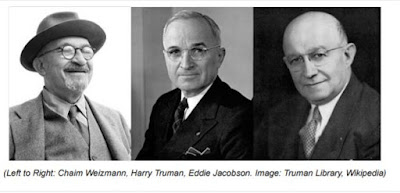My last post looked at the penning of the Partition Plan in the United Nations as the summer of 1947 came to a close. Let's keep exploring!
Most nations were not in favor of Partition, including the main world powers. The Soviet Union, an athiest communist country, certainly was not in favor of fulfilling biblical prophecy. Additionally, the American State Department had positioned itself against it. However, the American president was in favor of it. How did that happen?
Here we see another case of world history melding together with God's ancient purposes. Had the former US president been in power during that window of time, it is doubtful he would have sanctioned Israel's rebirth. However, in Franklin D Roosevelt's last re-election, he chose a new vice president - Harry S. Truman. Three months into his fourth term, FDR died, giving Truman a very sudden promotion.
Even Truman was nervous about supporting Partition in the face of worldwide hostility toward it. However, his former business partner, a Jewish man named Eddie Jacobson, met with Truman and implored him to meet with Chaim Weizmann. It is reported that Truman resisted, but in the end, he declared to Eddie, "You win, you bald-headed son-of-a-b$#%." He met with Weizmann and walked away from that meeting in full support of a Jewish state.
 |
| Not a joke: two Jews and a Baptist entered into a piece of history. |
Even the Russian dictator Stalin began to see the value of a Jewish state in the Middle East that would oust the British and possibly increase their own influence in the area.
When the vote for Partition came up in the United Nations on November 29, 1947, the resolution passed with 33 votes for, 13 votes against, and 10 abstentions.
The date of the vote also happened to be the Sabbath. The weekly Torah portion included Genesis 32:9, which includes the command, return to your native land.
The context of that scripture is Jacob returning to his land years after fleeing from his brother Esau. It was during that return trip that Jacob wrestled with the LORD, and he would not give up until the LORD blessed him.
When the vote came up, no name had been assigned to to the resurrected Jewish state. Several different names had been proposed, including Judah and Zion. But on the day of the UN vote, the name would be revealed to the world: Israel.
Remarkably, Genesis 32:28 was also included in that week's Torah portion, which stated You shall be called Israel. This is the first appearance of Israel in scripture. The Torah portion continued on that week to include Genesis 35:12, which says, To your descendants, I will assign this land.
All these details are so precise and exciting, but wait, there's more!
From the beginning, it has been God's word that initiates all things. He spoke the universe into existence. First the word, then the creation. First the word, then the restoration.
Down by the Dead Sea, a Bedouin shepherd boy was passing the time by chucking rocks into holes in the cliff. After one such launch, he heard a shattering sound. What followed was the discovery of the most significant archaeological discovery of modern times - the Dead Sea Scrolls. The Bedouin boy and a friend brought their find to an Arab merchant in Bethlehem.
 |
| Dead Sea caves at Qumran |
These scrolls had been hidden in the caves by a Jewish group called the Essenes almost two thousand years earlier, when Rome was driving the Jews from the land. There is almost nowhere else in the world that these scrolls would have survived for that length of time, but the extra dry climate of the Dead Sea was an ideal hiding place.
The most celebrated of the scrolls was the scroll of Isaiah. It was found in that very first cave and was preserved in its entirety. Isaiah includes beautiful prophetic words of Israel's restoration, including 11:12, which declares, He will raise a signal for the nations and will assemble the banished of Israel, and gather the dispersed of Judah from the four corners of the earth.
The head of Hebrew University's archaeology department, Eliezer Sukenik, was able to obtain the scrolls from the Bethlehem merchant and bring them back to his home. As Eliezer carefully began unrolling the scrolls, his younger son Mati was listening to the radio in the next room. Mati kept rushing back and forth to tell his father what he was hearing. The UN vote was being broadcast to the world. It was November 29, 1947.
 |
| UN Partition vote |









